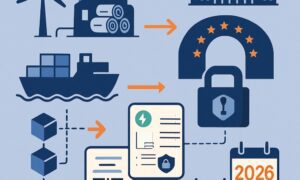In recent years, corporations around the world have been under growing pressure to address their environmental impact. From regulatory initiatives to evolving customer expectations, sustainability is no longer an optional extra, but a strategic priority. Today, technology is enabling the transition to a low-carbon economy, empowering businesses with the tools they need to measure and reduce greenhouse gas emissions. Artificial intelligence (AI), big data analytics, and emerging green technologies are driving meaningful change. At the same time, policy frameworks such as the Greenly help regulate corporate behavior and accelerate the transition. In particular, the Carbon Border Adjustment Mechanism (CBAM) is rapidly becoming a key part of the global climate strategy.
AI and Big Data: A New Era of Climate Management
AI is revolutionizing the way companies collect, analyze, and understand sustainability data. Through smart algorithms and advanced predictive analytics, organizations can now track their carbon usage in real time and detect patterns that would typically remain hidden. This improves the precision of emissions reporting and helps identify activities and processes with the highest environmental impacts. The combination of machine learning and large-scale data sets means businesses can predict consumption, optimize industrial processes, and ultimately reduce energy consumption. A growing number of manufacturers now rely on AI-enabled digital twins to simulate potential improvements and assess the environmental effects before implementing them in the real world.
This type of analysis is particularly useful in supply chain management, where much of a company’s carbon footprint tends to originate. AI can identify low-carbon suppliers, propose alternative transportation routes, and even automate purchasing decisions that support sustainability objectives. Moreover, AI makes it possible to integrate weather patterns and climate risk into operational planning. Data-driven forecasts help industries anticipate resource availability and minimize waste generation. These advances are not only good for the planet; they also help companies remain agile and competitive in a fast-changing business landscape.
Green Technologies: Transforming Industrial Operations
Alongside AI and advanced analytics, new green technologies are transforming the way goods are produced, transported, and consumed. Renewable energy systems, smart grids, energy storage and circular economy solutions are now being integrated directly into industrial operations. Photovoltaic systems and on-site wind farms reduce the need for fossil fuels, while smart grid solutions facilitate demand-response and energy sharing. In manufacturing, closed loop systems help recycle waste products and reduce the use of raw materials. Carbon capture and storage (CCS) technologies are also gaining traction and are increasingly becoming part of long-term decarbonization strategies.
Companies across several sectors have implemented IoT-enabled sensors to monitor resource consumption and send real-time alerts when energy consumption spikes. Combined with automated control systems, this enables accurate emissions measurement on the production floor and offers a pragmatic path toward carbon neutrality. These long-term improvements help businesses reduce operating costs while strengthening their sustainability commitments.
CBAM: A New Regulatory Landscape
Although technology plays a critical role in reducing emissions, policy is just as important. The EU’s Carbon Border Adjustment Mechanism was introduced to encourage emission reductions at a global level by placing a carbon price on goods imported into the European Union. CBAM ensures that foreign producers follow the same carbon pricing schemes as EU producers and creates a level playing field for international trade. As the mechanism enters its gradual phase-in period, companies importing goods such as cement, steel, aluminum, and fertilizers into Europe will need to report the embedded emissions of their products and pay a corresponding carbon price.
The complexity of CBAM reporting requirements means businesses will have no choice but to adopt digital tools that accurately track carbon data across the supply chain. Companies that fail to comply may encounter administrative penalties, higher compliance costs, and reputational damage. To stay competitive, companies should therefore explore smart solutions built specifically to monitor emissions and facilitate compliance with CBAM’s reporting obligations.
Connecting the Dots – How Technology Supports CBAM Compliance
Digital solutions are particularly useful in helping businesses implement carbon pricing and systematically reduce emissions over time. One example is Greenly, which provides an end-to-end platform for tracking carbon emissions. With automated data collection, detailed dashboards, and expert guidance, Greenly enables organizations to calculate their carbon footprint and establish a tailored low-carbon strategy. This makes it easier for businesses to comply with regulations such as CBAM and demonstrate their commitment to sustainability.
Greenly’s advanced platform provides full traceability of emissions across the value chain and helps companies identify the most impactful areas for reduction. Beyond compliance, these tools provide a strong foundation for long-term decarbonization strategies. Thanks to Greenly, companies can align their business models with the objectives of the Paris Agreement and build more resilient and future-proof operations.
Looking Forward
Technology will continue to play a defining role in the ecological transition. AI and big data offer unprecedented visibility and optimization capabilities, while green technologies redefine the way we generate and consume energy. Regulation such as CBAM further reinforces the need for transparency and accountability. Together, these forces create an environment in which sustainability and competitiveness are no longer mutually exclusive, but closely aligned. Companies that rely on solutions like Greenly will be well-equipped to navigate this new landscape and build a sustainable edge.
By investing in the right technological tools, businesses can ensure compliance with CBAM, reduce their environmental impact, and participate proactively in the global fight against climate change.



































